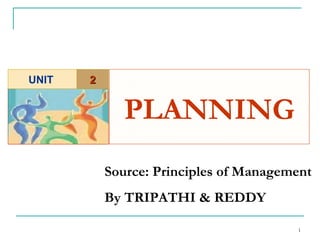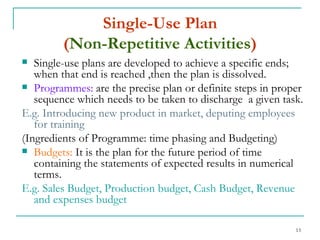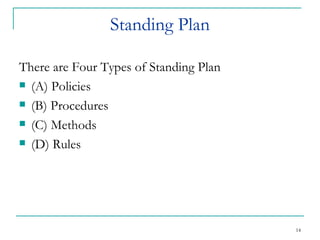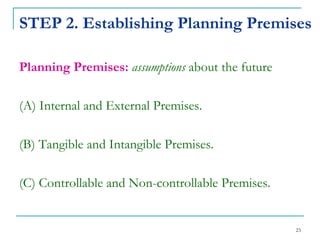planning
- 1. PLANNING Source: Principles of Management By TRIPATHI & REDDY 2 UNIT
- 2. OBJECTIVE OF STUDY Nature and Purpose of Planning. Importance of Planning. Forms of Planning. Types of Plans. Steps in Planning. Limitation of Planning.
- 3. Nature and Purpose of Planning Beginning of the process of management. Planning is an intellectual process . Decision Making is an integral part of planning. Manager has to decide on Goals, assumption, resource Planning is a continuous process. ( principle of navigational change ) Plan must be flexible. Flexibility in FIVE major areas Technology, Market ,Finance, Personnel and organization Planning is an all-pervasive function.
- 4. Importance of Planning Minimizes Risk and Uncertainty Leads to success Focuses attention on the organizationŌĆÖs goals Facilitates Control
- 5. Forms of Planning Strategic Planning 1. Decides major goals and policies of allocation of resources to achieve the goals. 2.Done at the HIGHER level of management 3. It is LONG-TERM 4.Generally based ON LONG-TERM FORECAST about technology, political environment and is more certain. Tactical Planning 1 . Decides the detailed use of resources for achieving each goals. 2.Done at the LOWER level of management 3. It is SHORT-TERM 4.Generally based PAST PERFORMANCE of the organization and is less uncertain.
- 6. Forms of Planning Strategic Planning 5. It is less detailed because it is not involved with the day-to-day operations of the organisation.. Tactical Planning 5. It is more detailed because it is involved with the day-to-day operations of the organisation..
- 7. Types Of Plan Objectives Strategies Single-Use Plan (Programmes and Budgets) Standing Plan (Policies ,Procedures, Methods and Rules) For Non-repetitive Activities For Repetitive Activities
- 8. Objectives Objectives are the goals which the management wishes the organization to achieve. ( Specific Targets ) Objective should be distinguished from other words ŌĆ£VisionŌĆØ, ŌĆØPurposeŌĆØ and ŌĆ£MissionŌĆØ Vision: is the dream that an entrepreneur creates in his /her waking hours of his/her preferred future. Purpose: The primary role defined by the society in which it operates. ( Broad Aim ) Mission: It is the unique aim that sets the organisation apart from others of its types. (specialization)
- 9. Characteristics of Objectives Objectives are multiple in number. ( Market standing,innovation,prductivity,profitability, manager performance and development,workers performance and attitude, Public responsibility) Objectives are either tangible or intangible. Objectives have a priority. E. g.: Finance department, University Objectives are generally arranged in hierarchy (Corporate Objectives, divisional objectives, section objective, individual objectives) Objectives sometimes clashes with each other
- 10. Requirement of sound objectives Objectives must be both clear and acceptable Objectives must support one another (T here must be close-Knit between long-range and short term objectives ) Objectives must be precise and measurable Objectives should always remain valid
- 11. Advantage of objectives Provide basis for planning Acts as a motivators for individuals and department. Eliminates haphazard actions Facilitates the coordinated behavior of various groups. It functions as a basis for managerial control Facilitate the better management of the enterprise Lessen the misunderstanding and conflicts and facilitate the communication Provide legitimacy of organization's activities
- 12. Strategies Two important activities involved in strategy formulation areŌĆ”. Environmental appraisal Political and legal factors Economic factors ( level of eco development & distribution of income, trend in prices ,exchange rate ,BOP, supply of labour, material, capital ) Competitive factors Social and cultural factors Corporate Appraisal ( leadership, excellent product design, efficient distribution and customer service, logistics, effective sales promotion, ability to influence legislation )
- 13. Single-Use Plan ( Non-Repetitive Activities ) Single-use plans are developed to achieve a specific ends; when that end is reached ,then the plan is dissolved. Programmes: are the precise plan or definite steps in proper sequence which needs to be taken to discharge a given task. E.g. Introducing new product in market, deputing employees for training (Ingredients of Programme: time phasing and Budgeting) Budgets: It is the plan for the future period of time containing the statements of expected results in numerical terms. E.g. Sales Budget, Production budget, Cash Budget, Revenue and expenses budget
- 14. Standing Plan There are Four Types of Standing Plan (A) Policies (B) Procedures (C) Methods (D) Rules
- 15. (A) Policy ŌĆ£ Policy is a verbal, written, implied overall guide, setting up boundaries that supply the general limits and direction in which the managerial actions will takes place ŌĆ£ . -George R Terry Advantages of Policy 1. Ensure the Uniformity of actions in respects of various matters at various organizational points. 2. Speed up the decisions at the lower levels 3.It is easier to delegate the authority to the subordinates 4. Policies give a practical shape to the objectives by elaborating and directing the way in which the predetermined objectives are to be attained
- 16. Types of Policy On the basis of sources 1. Originated Policies 2. Appealed Policies 3. Implied Policies 4.Externally imposed Policies On the basis of functions On the basis of organizational level ( Major Company policies, Minor derivative policy applicable to segments )
- 17. Guideline for effective policy-making Should be in writing and understood by all. Reflects the objectives of organization , define method and action. Top managers and Subordinates should participate in its formulation Must strike a balance between stability and flexibility. Policies should not pull in different directions Should not be detrimental to the interest of society Should cover as many contingencies as possible Policies should be periodically reviewed
- 18. Procedures Policies Guide to both thinking and actions of people at higher level Helps in fulfilling the objectives are broad and allow some discretion Often established without any detailed study Procedure Guide to action only for people at lower level Shows the way to implement the policies Are specific and lay down the sequence of definite act Often established after thorough study and analysis of work A Procedure Provides a detailed set of instructions for performing a sequence of actions involved in doing a certain piece of work
- 19. Advantages & Limitation of Procedure Advantages Standard way of performing a task Work simplification and elimination of unnecessary steps Facilitates control over performance Enable the employee to improve their efficiency Limitation Limits the scope for innovation
- 20. Methods and Rules Methods: Prescribed way in which one step of a procedure it to be performed. It helps in increasing the effectiveness and usefulness of procedure. Rules: Detailed or recorded that a specific actions must /must not be performed in a given situations. e.g. Sanctioning overtime, travelling allowance ,Uniform way of handling employee
- 21. Steps in Planning 1. Establishing verifiable goals or set the goals to be achieved. 2. Establishing Planning premises. 3. Deciding the planning period. 4. Finding alternative courses of action. 5. Evaluating and selecting a course of action. 6. Developing derivative plans. 7. Measuring and controlling the progress.
- 22. STEP 1. Set the goals to be achieved Desired sales volume or sales growth Development of a NEW product More abstract goals like becoming more popular in the community. Setting the goals will depend on a number of factorŌĆ” 1.Mission 2. Value 3. Actual and potential abilities of the organisation
- 23. STEP 2. Establishing Planning Premises Planning Premises: assumptions about the future (A) Internal and External Premises. (B) Tangible and Intangible Premises. (C) Controllable and Non-controllable Premises.
- 24. Steps 3: Deciding the planning period Factor influencing the choice of the periodŌĆ” (A) Lead time in development and commercialization of a new product (B) Time Required to recover the capital investments or the pay back period. (C) Length of the commitment already made.
- 25. Steps 4: Finding the alternative courses of action E.g. Technological Know-How, Product distribution Steps 5: Evaluating and selecting the best course of action Steps 6: Developing the derivatives Plan Derivative Plan: Broad goals must be translated into day-to-day operations of the organization. Steps 7: Measuring and controlling the progress
- 26. Limitation of Planning 1. Planning is an expensive and time-consuming process. 2. Planning sometimes restricts the organization to the rational and risk-free opportunities. 3. The scope of planning is limited in organization with rapidly changing situations. 4. Flexibility of planning can not be maintained. 5. Difficulty of formulating accurate premises. 6. Planning may sometimes face peoples resistance to it.
- 27. Thank You


























